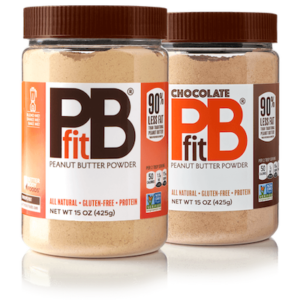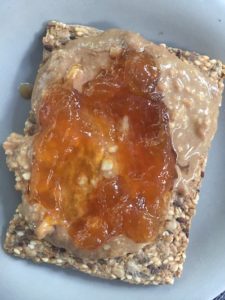Instant Pure Peanut Butter with PBfit
 (Gerry Furth-Sides, product photos courtesy of the company). As someone who cannot be trusted with a full jar of peanut butter in the fridge – even knowing how healthy it is – I try to compensate by eliminating the bread eating peanut butter on a spoon with jam. If there is a downside too, it is that there is no “crunch” version, although there is one with chocolate.
(Gerry Furth-Sides, product photos courtesy of the company). As someone who cannot be trusted with a full jar of peanut butter in the fridge – even knowing how healthy it is – I try to compensate by eliminating the bread eating peanut butter on a spoon with jam. If there is a downside too, it is that there is no “crunch” version, although there is one with chocolate.
The PBfit product is the answer. It is ready to use by diluting it with water to eat in a tablespoon. It can be used anywhere a recipe calls for regular peanut butter, just make the peanut butter powder to its creamy form by adding water and mixing, then use in the desired recipe. You can use it in the powdered form when making smoothies, ice cream, in hot cocoa and, of course, sandwiches. Here is my favorite open-faced one on Norwegian crisp.
PBfit is the thinking person’s way of eating peanut butter. You can’t just open a jar and dig into it. The good part is that is pure peanut butter in a 2 tbsp serving, there are 1.5g fat, 4 carbs, and 5g protein.
For a most descriptive and helpful article that includes 32 recipes of different ways to use PBfit, please see: //www.getfitgofigure.com/33-uses-for-pb-fit-peanut-butter-powder/. The photos alone are inspiring. It includes such helpful tips as making protein shakes more peanut-ty by simply adding a spoonful of peanut butter powder to a regular protein shake using 36g of chocolate protein, 80g of frozen bananas, 4 Tbsp PB Fit and 6-8oz of liquid.
Ideas include entirely different tasting dishes by simply add teaspoons of PB Fit powder to brownies, applesauce cookie bars, pancake or even dark chocolate waffle batter for a roasted peanut taste in Dark Chocolate Peanut Butter Waffles
Other interesting ideas include Thai peanut sauce and peanut butter curry made with PB Fit and include lower fat options. See recipe here. Recipe creators suggest that when a texture is involved, use half real PB and half PBfit is a good idea Make sure the PBfit is the correct consistency before adding it to the recipe.
Healthy peanut butter banana ice cream is made with coconut milk, frozen bananas, and PBfit into a food processor. Lighter options are provided. Recipe Here.
Peanut butter swirled brownies can be made by simply whipping up the batter, pouring it into the greased pan, and then using a knife to swirl two tablespoons of PB Fit through the batter before baking as directed.
No-bake granola bars with a dash of PBfit in place of regular PB are quick to make. Adding powdered PBfit to a mug of hot chocolate is even quicker, and so is sprinkling a teaspoon of PBfit powder over dry cereal or warm oatmeal. Drizzling a little warm PBfit peanut butter + butter over a batch of popped popcorn adds a gourmet touch. And finally, an original savory option for any meal arrives in a recipe for peanut butter cocoa chili with PBfit, along with chicken or ground turkey for a real low-fat recipe. Recipe here.
Peanut butter plays an important part in American agricultural history. Legendary, influential innovator, George Washington Carver, helped develop peanut butter as part of his major achievement of developing crop-rotation. After earning his master’s degree at Iowa Agricultural College (Iowa State University) in 1897, Carver was brought into Tuskegee Institute as director of agriculture, where he developed a nitrate-enriched legume and cotton crop rotation system. There, Carver found 325 uses for the excess crop material after rotation — such as peanut oil — which contributed to developments of the delicious sandwich spread, peanut butter.
For more details on George Washington Carver’s life, please see his bio at //www.invent.org/honor/inductees/inductee-detail/?IID=30.
Peanut butter was originally paired with savories, such as celery or toasted crackers until 1896 when Good Housekeeping Magazine suggested home-ground peanut butter spread on bread. At the turn of the century when the price of peanut butter dropped and became even more popular in the 1920s when sugar was added and it appealed more to children. By World War II, both peanut butter and jelly were found on US soldiers’ military ration list.




 Gerry Furth-Sides
Gerry Furth-Sides  Barbara Hansen
Barbara Hansen  Chef-owner Alain Cohen
Chef-owner Alain Cohen  Roberta Deen
Roberta Deen  Jose Martinez
Jose Martinez  Nivedita Basu
Nivedita Basu